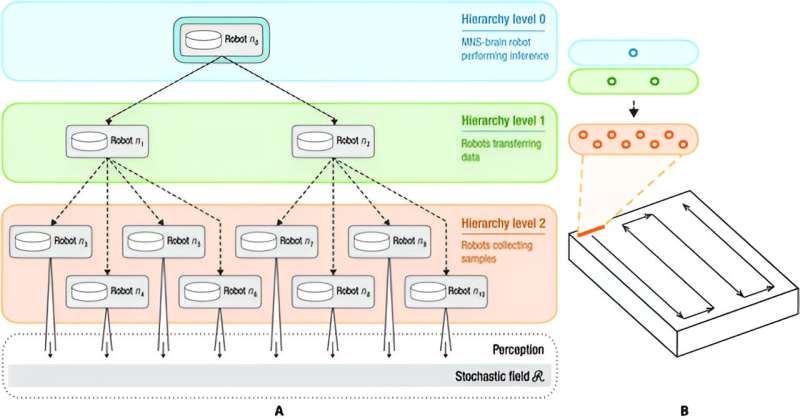
Making group choices isn’t any simple job, particularly when the choice makers are a swarm of robots. To extend swarm autonomy in collective notion, a analysis staff on the IRIDIA synthetic intelligence analysis laboratory on the Université Libre de Bruxelles proposed an revolutionary self-organizing method by which one robotic at a time works briefly because the “mind” to consolidate data on behalf of the group.
Their paper was printed in Clever Computing. Within the paper, the authors confirmed that their methodology improves collective notion accuracy by decreasing sources of uncertainty.
By combining elements of centralized and decentralized management, the authors realized the advantages of each in a single system, sustaining the scalability and fault tolerance of decentralized approaches whereas incorporating the accuracy of centralized ones. The method permits robots to grasp their relative positions inside the system and fuse their sensor data at one level with out requiring a world or static communication community or any exterior references.
Moreover, the authors’ method permits centralized strategies for fusion of knowledge from a number of sensors to be utilized to a self-organized system for the primary time. Multi-sensor fusion methods have been beforehand solely demonstrated in totally centralized programs.
The authors examined the self-organizing hierarchy method towards three benchmark approaches and located that their method excelled by way of accuracy, consistency and response time underneath the examined situations. Within the experimental setup, a swarm of simulated drones and floor robots collects two-dimensional spatial information by detecting objects scattered in an area and types a collective opinion of object density. The robots should depend on their short-range sensors to infer the variety of objects per unit.
This new method, based on the authors, makes use of a “dynamic ad-hoc hierarchical community.” It’s constructed on a kind of common framework referred to as a mergeable nervous system, the place robots at every stage of the hierarchy have completely different roles within the decision-making processes and robots can change their connections and relative positions as wanted, although every robotic is restricted to speaking solely with its direct neighbors.
Within the authors’ method, the “mind” robotic on the prime stage is liable for performing inferences and sending movement directions downstream, whereas the robots on the center stage handle information switch and take part within the balancing of worldwide and native movement targets (for example, throughout impediment avoidance), and the bulk on the backside stage carry out pattern assortment whereas managing native movement.
Future analysis on the subject may examine superior inference strategies and develop on the robustness of sampling strategies underneath additional sorts of robotic failures or difficult environmental situations, resembling environments with massive obstacles or irregular boundaries.
Extra data:
Aryo Jamshidpey et al, Decreasing Uncertainty in Collective Notion Utilizing Self-Organizing Hierarchy, Clever Computing (2023). DOI: 10.34133/icomputing.0044
Offered by
Clever Computing
Quotation:
How do robots collaborate to realize consensus? (2023, September 14)
retrieved 14 September 2023
from
This doc is topic to copyright. Other than any honest dealing for the aim of personal examine or analysis, no
half could also be reproduced with out the written permission. The content material is offered for data functions solely.
#robots #collaborate #obtain #consensus


